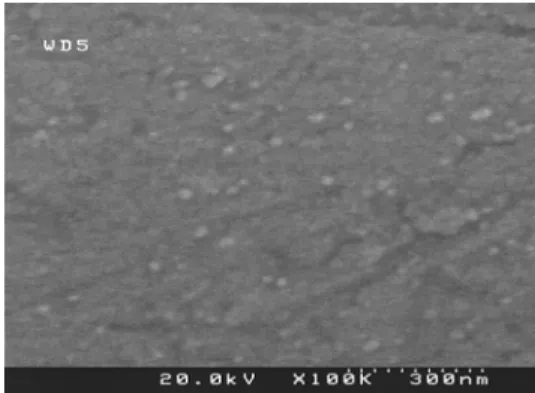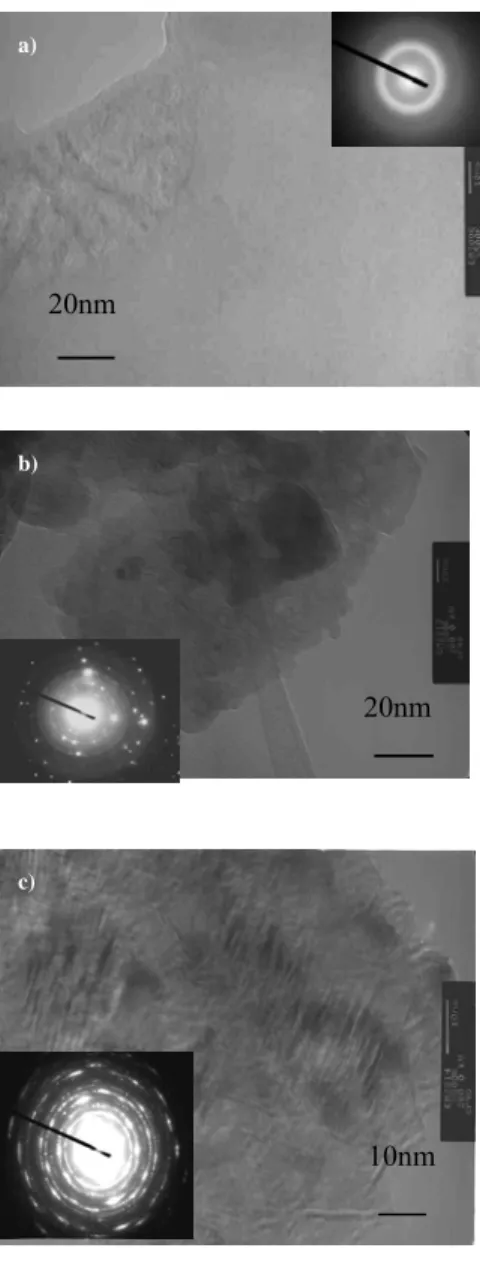1 Abstract— Al based alloy powders (Al85Ni5Y6Co2Fe2) are produced by spray atomization method. High energy ball milling is done to modify the surface topology and particle size for better electrochemical performance. X ray diffraction (XRD), differential scanning calorimeter (DSC), scanning electron microscope (SEM) and transmission electron microscope (TEM) were conducted to characterize the microstructure of the alloys after ball milling. It is found that 5 hours ball milling gives the minimum crystallization and structure change. Thin film sample is also deposited on stainless steel substrate by pulsed laser deposition (PLD) method for electrochemical test. The capacity and reversibility for different samples are compared and discussed. A capacity of 200mAh/g is obtained for the battery with thin film sample as anode and a capacity of 140mAh/g is obtained for that with electrode from powder sample. Both of the batteries give up to 94% capacity retention after 20 cycles.
Index terms—Bulk metallic glass, Lithium Ion battery, Al alloy, spray atomization, pulse laser deposition
I. INTRODUCTION
Recently metallic anode materials have been widely investigated for their high theoretic capacity in rechargeable Lithium batteries. [1-14] As compared to conventional graphite material with 372mAh/g specific capacity, Si offers up to 4200mAh/g, Al and Sn gives around 990mAh/g theoretic specific capacity. However the capacity fading is significant due to imhomogenous volume expansion when the metallic material is lithiated. [1-4, 10-13] Poor capacity retention is caused by volume expansion induced pulverization, leading to the high contact resistance during cycling. [1-2]
Many systems have been studied to address this issue. The systems with great potential are amorphous alloys [10-14] and active materials embedded inside an inactive matrix [15-18]. The inactive matrix serves as a host for nano-dispersed active material and the volume expansion of the active material. Many composite materials including alloys [6-7]and oxides [15-18] have been studied and show potential for improved reversible capacity. The drawback of this composite system is the trade-off between cycleability and specific capacity.
Amorphous alloy materials show homogenous volume expansion during lithium insertion with no pulverization and high cycleability. [10-14] Si based amorphous material is the one has been widely studied among all the possible amorphous alloys as anode application for lithium ion batteries. [10-14] Sn, Al, and some transition metals are normally doped in Si based material to reduce the resistivity. At present, most of the studies in this area are still focus on thin film materials.
Another family of alloys with good glass forming ability is Al based. [18] In this work, we explore the possibility to use Al based bulk metallic glass as anode material for rechargeable lithium batteries. Different techniques such as melt-spun and spray atomization have been employed for producing Al based bulk metallic glass powders. Thin film sample is also made by pulsed laser deposition. The microstructure and the capacity of different samples have been studied.
II. EXPERIMENTAL
1. Al85Ni5Y6Co2Fe2 powders by spray atomization method and pulse laser deposition.
The powders by spray atomization method were milled in ethanol as control agent using Spex8000 high-energy mixer for 5, 15 and 30 hours respectively. The powders are allowed to rest 15 minutes for every 15 minutes ball milling intervals to reduce the heat accumulation, leading possible crystallization.
The aluminum, nickel, yttrium, cobalt and iron with above 99.9% purity were arc-melted and homogeneously mixed under argon atmosphere according to the nominal compositions of 85:5:6:2:2 (atomic percentage) respectively. The mixture was cooling down and made as the target for pulse laser deposition. Thin film sample was deposited on stainless steel using Complex 205F excimer Laser (KrF) with a wavelength of 248 nm at pulse energy of 250mJ and a frequency of 10Hz. The deposition chamber is ultrahigh vacuum (2*10-8tor) from Neocera Inc.
The above samples were characterized with TA instrument Differential Scanning Calorimeter, a Philip x-ray diffractometer with a Cu Kα x-ray radiation, a JEOL
A
MORPHOUSA
L-T
RANSITION METALA
LLOYS ASA
NODEM
ATERIAL FORL
ITHIUMI
ONB
ATTERYC.Y. WANG1, LI Yi1,2 andG. CEDER1,3
1
Singapore-MIT Alliance, Advanced Materials for Micro- and Nano- Systems Programme, Engineering Drive, Singapore 117576 2
Department of Materials Science, National University of Singapore, Lower Kent Ridge, Singapore119260 3
2 FEG-SEM and a JEOL TEM-100CX transmission electron transmission electron microscope (TEM) operating at 100kV.
2. Electrochemical test
Swagelok-type test cells were assembled using these samples as the positive electrode, Celgard 2500 micro porous polyethylene membrane as the separator and a 0.75mm thick lithium foil as the negative electrode. The electrolyte was 1.0 M LiPF6 in ethylene carbonate (EC): dimethylcarbonate (DMC) by volume ratio 1:1. Cells were assembled in an argon-filled glove box, where moisture level is less than 1ppm. All cells were tested using a Maccor 4000 series battery tester.
After 5 hours ball milling, Al85Ni5Y6Co2Fe2 powers become very small, less than 100nm. Large amount of binder and carbon were added for better battery performance. Slurries with 50%wt active materials, 25% wt PVDF and 25%wt Super-S carbon black were dried on Cu substrate at 100C in Ar environment for 10 hours.
III. RESULTS AND DISCUSSION
1. Structure characterization of Al85Ni5Y6Co2Fe2 powers by spray atomization method
The ribbon shape Al85Ni5Y10 is very ductile and is difficult to be made into powders for electrochemical test. We therefore make the Al85Ni5Y6Co2Fe2 powders with similar composition by spray atomization method. The SEM analysis of the Al85Ni5Y6Co2Fe2 powders is shown in Fig. 1a. The powders show nice round ball shape particles with size ranging from 1-20µm. To reduce the particle size for better battery performance, ball milling was carried out and result is given in Fig. 1b. After ball milling for 5 hours, the particle size has been reduced to less than 100nm.
Fig. 2 shows the DSC results of the original Al85Ni5Y6Co2Fe2 and after ball milling for 5, 15 and 30 hours. After 5 hours ball milling, there is a slightly change in the crystallization temperature but no obvious change in the crystallization enthalpy. After 15 and 30 hours ball milling, the height of the crystallization peaks decreases but the width increases, showing major structure change. To further understand the structure change upon ball milling, we did XRD analysis and TEM as shown in Fig. 3 and 4. From the XRD data, the height of the Al crystalline
peak is also reduced after ball milling and the width increases, indicating the reduction of the crystalline size. Roughly estimate from the crystal peak on the XRD spectra, there is around 6%crystalline in the Al85Ni5Y6Co2Fe2 alloy. As compared to the XRD spectrum of Al85Ni5Y10 in previous work, it is shown that by substitute 4 atomic percent Y with 2% Co and 2% Fe, the glass forming ability is reduced. The average crystal size of the original powder is larger than 100nm, after 5hours ball milling is less than 20nm.
Fig. 1. SEM picture of the Al85Ni5Y6Co2Fe2, a) before ball milling
b) after ball milling for 5 hours
Fig. 2. Differential scanning calorimetry result for glassy Al85Ni5Y6Co2Fe2 before and after ball milling for 5, 15 and 30
hours. 350 450 550 650 750 Tem p (C) h e at f lo w ( a .u .) Original 5hrs 15hrs 30hrs
3 Fig. 3 X-ray diffraction spectra of Al85Ni5Y6Co2Fe2 before and
after ballmilling for 5 hours.
Fig. 4 TEM pictures of the respective Al85Ni5Y6Co2Fe2 ball
milling powders after 5hrs a), 15 hrs b) and 30hrs c) 2. Electrochemical testing
Electrodes made by Al85Ni5Y6Co2Fe2 powders after 5 hours ball milled were cycled at 50µA from 3V to 0V. Figure 5 shows the charge/discharge cycles under C/7 for 0.5mg active material. The slope curve indicates no crystallization took place during the charge/discharge process. The first discharge capacity is around 600mAh/g. The reversible capacity is around 250mAh/g. After the deduction of the contribution from the 25% carbon, the capacity from the active material is around 140mAh/g only. Since the comparable contribution from both the active material and the carbon, the capacity is largely affected by the variation of the carbon concentration.
Fig. 5. Charge/discharge curves on 5 hours ball milling Al85Ni5Y6Co2Fe2 at 50 µA per 0.5mg (C/7).
Fig. 6. Charge/discharge curves on Al85Ni5Y6Co2Fe2 thin film
deposited by PLD at 50 µA per 0.2mg (C/2.8).
To further clarify the capacity of Al85Ni5Y6Co2Fe2 alloy, we cycle the thin film sample with no addictives at 50µA from 3V to 0V. The charge/discharge curves are shown in Fig. 6. The first discharge capacity is around 350mAh/g.
25 35 45 55 65 75 2 theta In te n s it y original 5hrs 2 theta (degree) Inte nsity (a. u. ) a) 20nm b) 20nm c) 10nm 0 0.5 1 1.5 2 2.5 3 3.5 0 100 200 300 400
Cap Density (m Ah/g)
Vo lt a g e ( V )
Specific Capacity (Ah/kg)
Cell V oltag e (V ) 0 0.5 1 1.5 2 2.5 3 3.5 0 100 200 300 400 500 600 700
Cap den. (m Ah/g)
V o lt ag e ( V )
Specific Capacity (Ah/kg)
Cell V
oltage
(V
4 The reversible capacity is around 200mAh/g and gives 94% capacity retention up to 20 cycles. The extra capacity from the first discharge is suspected due to SEI formation.
I. CONCLUSIONS
From the structure of Al80Ni10La10 and Al80Cu10La10, it is shown that Ni is a better glass former element as compared to Cu. With the increasing of the amorphous content in Al80Ni10La10, the capacity retention is largely improved but the capacity is reduced. Using Ni and Y as glass forming element, the glass forming ability is largely improved. Bulk metallic glass, Al85Ni5Y6Co2Fe2 with only around 6% crystalline phase is obtained. By choosing proper glass forming element, both the capacity and capacity retention has been largely improved for Al85Ni5Y6Co2Fe2 as compared to Al80Cu10La10 and Al80Ni10La10 made by melt spun method. However, the capacity is still much lower than the theoretical capacity.
Computational study is carrying out to understand the electrochemical behavior of the Al base alloys.
REFERENCES
1. L. Y. Beaulieu, S. D. Beattie, T. D. Hatchard and J. R. Dahn, J. Electrochem. Soc., 150 (2003) A149 2. C. Wang, A. J. Appleby and F. E. Little, J Power
Sources, 93 (2001) 174
3. Y. Wang, J. Y. Lee and T. C. Deivaraj, J. Electrochem. Soc., 151 (2004) A1804
4. C. Arbizzani, s. Beninati, M. Lazzari and M. Mastragostino, J. Power Sources, 141 (2005) 149 5. C. Arbizzani, M. Lazzari and M. Mastragostino, J.
Electrochem. Soc., 152 (2005) A289
6. O. Mao and J. R. Dahn, J. Electrochem. Soc., 146 (1999) 423
7. L. Y. Beaulieu and J. R. Dahn, J. Electrochem. Soc., 147 (2000) 3237
8. D. Larcher, L/ Y/ Beaulieu, O. Mao, A. E. George and J. R. Dahn, J. Electrochem. Soc. 147 (2000) 1703
9. M. D. Fleischauer, J. M. Topple and J. R. Dahn, LiBD-3, Arcachon, France, 22-27, May 2005 10. L. Y. Beaulieu, T. D. Hatchard, A. Bonakdarpour,
M. D. Fleischauer and J. R. Dahn, J. Electrochem. Soc., 150 (2003) A1457
11. L. Y. Beaulieu, K. W. Eberman, R. L. Turner, L. J. Krause and J. R. Dahn, Electrochem. Solid-State Lett., 4 (2001) A137
12. T. D. Hatchard, J. M. Topple, M. D. Fleischauer and J. R. Dahn, Electrochem. Solid-State Lett., 6 (2003) A129
13. Z. H. Chen, V. Chevrier, L. Christensen, J. R. Dahn, Electrochem. Solid State Lett., 7 (2004) A310
14. M. D. Fleischauer and J. R. Dahn, J. Electrochem. Soc. 151 (2004) A1216
15. J. H. Ahn, G. X. Wang, J. Yao, H. K. Liu, S. X. Dou, J Power Sources, 119 (2003) 45
16. I. A. Courtney, W. R. McKinno and J. R. Dahn, J. Electroche, Soc., 146 (1999) 59
17. J. Read, D. Foster, J. Wolfenstine, W. Behl, J. Power Sources, 96 (2002) 277
18. A. Inoue, Progress in Materials Science 43 (1998) 365
19. M.D. Fleischauer, J.M. Topple and J.R. Dahn, LiBD-3 2005 – Electrode materials. Arcachon, France 22-27 May 2005

